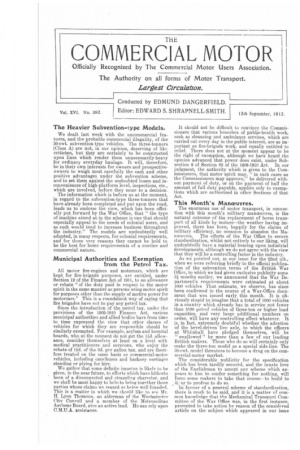This Month's Manoeuvres.
Page 1

Page 2

If you've noticed an error in this article please click here to report it so we can fix it.
The enormous use of motor transport, in connection with this month's military manceuvres, is the natural outcome of the replacement of horse transport of all kinds by motors—the weather having improved, there has been, happily for the claims of military efficiency, no occasion to abandon the Manceuyres. The efforts of the War Office to secure standardization, whilst. not entirely to our liking, will undoubtedly have a material bearing upon industrial developments, although we do not agree with the view that they will be a controlling factor in the industry. As we pointed out, in our issue for the 22nd ult., when we were referring briefly to the official publication of the subvention terms of the British War Office, to which we had given exclusive publicity some 3i months earlier, we announced that the War Department's requirements were estimated at about 1000 vehicles That estimate, we observe, has since been confirmed in the course of a War-Office document that was issued early, this month. It is obviously stupid to imagine that a total of 1000 vehicles in a country which already has in service not fewer than 5500 petrol vehicles of three-ton or higher load capacities, and very large additional numbers on order, will have any controlling effect whatever. It is, in fact, extremely doubtful whether the adoption of the bevel-driven live axle, to which the officers at Whitehall have pledged themselves, will be " swallowed " by more than a few of our leading British makers. Those who do so will certainly only make the three-ton model as a special side-line. The 30-cwt. model threatens to become a drug on the commercial-motor market.
The considerable publicity for the specification which has been tardily secured, and the innate love of the Englishman to accept any scheme which appears to him to confer something for nothing, will force some makers to take that course—to build to it or to profess to do so. ln favour of a general scheme of standardization, there is much to be said, and it is a matter of common knowledge that the Mechanical Transport Committee of the War Office was, in the first instance, prompted to take action by reason of the considered article on the subject which appeared in our issue
for the 22nd September, 1910. At that date, we may recall, while we were drawing attention to the chaotic state of the mechanical transport for the British Army, less well-informed writers were protesting that all was satisfactory and in a state of efficiency. It certainly was not. We have very little more to say, now, against the War Office scheme, except to repeat, in respect of the extraordinary adherence to the bevel type of live backaxle, that we think the parties concerned have acted both inadvisedly and indiscreetly. We refuse to believe that this design will be universally adopted, whatever good points it may possess for particular applications, and no matter how successfully one maker may have employed and exploited it.




















